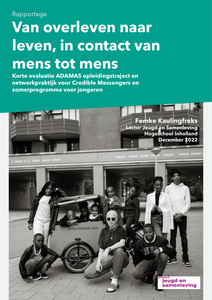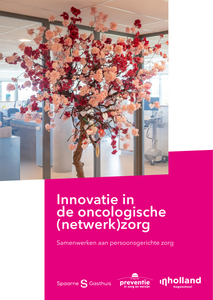Korte evaluatie ADAMAS opleidingstraject en netwerkpraktijk voor Credible Messengers en zomerprogramma voor jongeren
DOCUMENT

Op woensdagmiddag 4 juni heeft het consortium plaatsgevonden in het Spaarne Gasthuis. Er waren ca 18 deelnemers uit verschillende hoeken: onderzoek, vrijwilligers coördinatoren (hospice, adamas, spaarne), vrijwilligers, verpleegkundigen, verpleegkundig specialisten en ervaringsdeskundigen/leden van de cliëntenraad. De presentatie is bijgevoegd
DOCUMENT

Lectorale Rede van Harmieke van Os, woensdag 17-09-2025: In mijn rede heb ik uiteengezet dat het lectoraat Innovatie in de oncologische (netwerk)zorg zich richt op persoonsgerichte essentiële zorg door verpleegkundigen en verpleegkundig specialisten. Die zorg start in de zorgrelatie. Verpleegkundigen en verpleegkundig specialisten staan voor complexe opgaven: de zorgvraag neemt toe, terwijl er minder verpleegkundigen zijn, de impact van kanker op patiënten en hun naasten is groot en gezondheidsverschillen spelen een rol. Om persoonsgerichte zorg te bieden werken zij nauw samen in netwerken, zetten ze in op preventie en een gezonde leefstijl en maken ze gebruik van (digitale) innovaties. Het lectoraat wil via praktijkgericht onderzoek bijdragen aan de kwaliteit van leven en sterven van patiënten met kanker, en aan de professionalisering van verpleegkundigen en verpleegkundig specialisten. Ik heb een schets gegeven van drie met elkaar samenhangende onderzoeksthema’s: • Interprofessionele samenwerking in (netwerk)zorg; • Preventie door leefstijlverpleegkunde; • Innoveren in de oncologische zorg. Samenwerking is hierin essentieel. Ik heb het belang toegelicht van samenwerking met patiënten, verpleegkundigen, verpleegkundig specialisten, professionals uit zorg- en aanpalende domeinen, docenten en studenten. Samen werken we aan persoonsgerichte zorg!
DOCUMENT

This booklet presents twenty-one impact stories of Ethiopian and Kenyan alumni of Dairy (Livestock) trainings in the Netherlands. The Dutch trainings consists of Master courses conducted by Van Hall Larenstein University of Applied Sciences (VHL) in Wageningen or Velp, short courses or diploma courses organised by Practical Trainings Centre (PTC+) in Oenkerk or Barneveld / Dairy Trainings Centre (DTC) in Oenkerk and short courses organised by Centre of Development Innovation – part of Wageningen University and Research Centre (WUR) in Wageningen. Most refresher course participants attended the Dutch trainings between 2010 and 2018. These alumni attended the Refresher Course entitled “Assessing the impact of Dutch knowledge institutions on performance of Netherlands alumni on dairy value chain governance in Kenya and Ethiopia” organised by Van Hall Larenstein University of Applied Sciences (VHL), Agrikom (alumni organisation) and Egerton University on 7-16 July 2019 in Nairobi and Nakuru, Kenya. Part of the refresher course was dedicated to a write shop about the impact of the Dutch training. It was written in collaboration with the professorship Climate Smart Dairy Value Chains.
DOCUMENT

This magazine presents the highlights of the applied research project “Inclusive and climate-smart business models in Ethiopian and Kenyan dairy valuechains (CSDEK)”. The CSDEK applied research project was conducted in six case study areas, three in Ethiopia and three in Kenya. At the time of publishing this magazine, research was still ongoing in some of the study areas. The projectteam and researchers hope to contribute to creating awareness of climatesmartdairy practices and development of the dairy sector in Ethiopia and Kenya. In two of the study areas, collaboration between VHL and dairy stakeholders will continue, preferably through local networks in a Living Lab approach.
DOCUMENT
